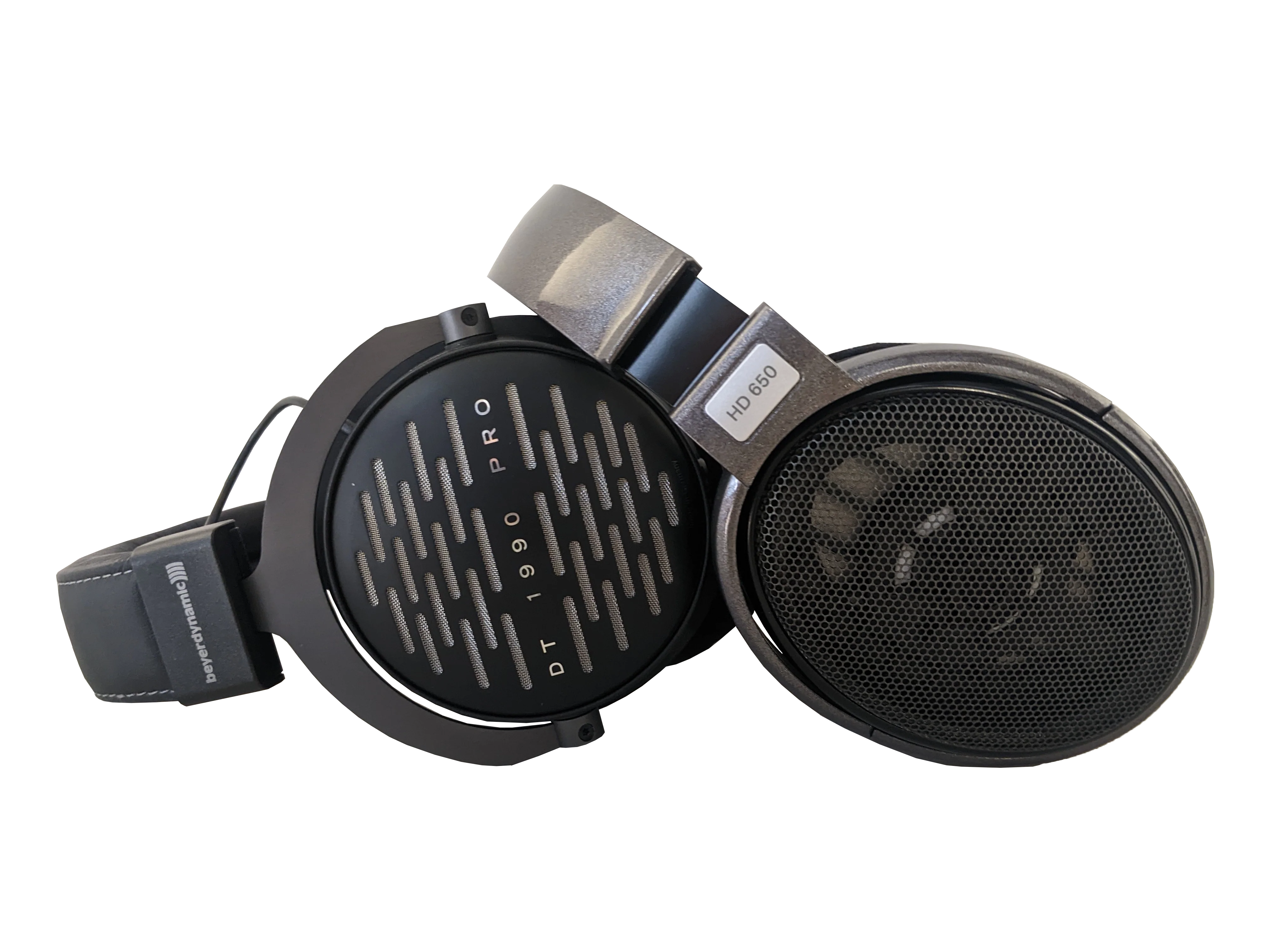Beyerdynamic DT 1990 Pro vs. Sennheiser HD 650 Headphone Comparison Review
As someone who mixes music, the pleasure is all mine for today's review. We'll be taking a look at some of the most popular open-back over ears that mixers and listeners alike reach for when they want a precise listen that stays true to the mix: the Beyerdynamic DT 1990 Pro and the Sennheiser HD650. Both fall in a moderately affordable price point, listed on their company sites at just about $550 each (though at the time of writing this review the DT 1990 Pro is selling for $479 from Audio46). What differences emerge between these two tried-and-true open-back headphones when they go head to head?

What's In The Box?
Beyerdynamic DT 1990 Pro
-DT 1990 Pro Headphones
-Hard carrying case
-Two 3 pin XLR to 3.5mm headphone cables (5m coiled and 3m regular)
-Two sets of ear pads ( for “Balanced” vs. “Analytical” listens)
Sennheiser HD 650
-Sennheiser HD 650 Headphones
-2 pin to 6.35mm headphone cable (3m)
Look and Feel
Let me get what I think is fairly obvious out of the way: the Beyerdynamic DT 1990 wins this round pretty squarely. Let's start with looks: the DT 1990 is a sexy, professional-looking headphone, with an open-back silver grill design that resembles acoustic diffusers that you would see in a music studio's control room that contrasts nicely with its black, metal housing. Metal sliders with just a touch of wiggle room attach the cans to the headband and are self-apparently very sturdy. The headband contains memory foam that is encased in a smooth, leathery material with white stitching lining the exterior-side border. The headband has some stiff wiggle as well – but I can tell that I wouldn't want to go too far in testing this. The earpads sat very pleasantly against my skin with their soft velour exterior stuffed with visco foam padding. Headband pressure was somewhat tight, but this is typical for headphones designed with mixing in mind and really did not cause me any discomfort.
The Sennheiser HD 650 showed up to the review a little under-dressed. Aside from the branding, there's not really any distinct or impressive aesthetic features. A plain black grill is fitted to the back of the cans, exposing the back of the driver and leaving it completely visible. While the metal sliders and wiggle-capable cans give a sense of durability, this is offset by what is quite obviously a very plastic build that Sennheiser tried to spruce up with some glossy silver coloring. On the interior head-side of the headband is some fairly comfortable foam padding, though has a kind of exposed, not-refined look to it. Finally, let's talk about the headband pressure. Just, why? Why so tight Sennheiser? While this characteristic is usually found on ANC headphones for maximum isolation, this is an open back – squeezing my head harder isn't going to make the room quieter! At least the velour ear pads provide some relief.
While the HD650 is significantly lighter than the DT 1990 at only 260 grams versus 370 grams, the DT 1990 is smooth, chic and comfy, while I think the no-frills Sennheiser HD 650 just flipped me off.

Design:
Beyerdynamic DT 1990 Pro
Impedance: 250 ohms
Frequency response: 5 Hz – 40 kHz
Weight: 370 grams
Driver: 45mm dynamic Tesla neodymium
Sennheiser HD 650
Impedance: 300 ohms
Frequency response: 12 Hz – 41 kHz
Weight: 260 grams
Driver: 42mm (38mm diaphragm)
Soundstage and Imaging
Luckily, the HD650 sounds a whole lot better than it looks. I commonly use “Deadbeat Summer” by Neon Indian to test imaging and staging, which the HD650 jumped on with extra fast reflexes. Not only does it have a satisfyingly wide left-right image, but it also sent the various phasers and filters present in the track snaking all around my head, sliding up from my chin and round and round in circles in front of my face. Overall, it exhibited quite vivid and precise imaging that effortlessly flipped tracks into a three-dimensional space. The long, ovular speaker shape seemed to contribute to its satisfyingly spatially layered character. In fact, I don't want to understate this: even if the fit of the HD650 isn't the best for comfort, it was certainly optimal for imaging.
Does the Beyerdynamic DT 1990 Pro compete? Yes, and it's even a close race, but the Sennheiser HD650 ultimately wins by a small margin. The DT 1990 had similarly excellent imaging, capable of the same sort of 3D swirling as the HD650, but lags behind it when it comes to the sheer height of the image. The HD650 really felt like it worked its way around every curve and crevice of my head, while the DT 1990 mostly stayed eye/ear level.
Balance and Timbre
As I mentioned earlier, both sets of headphones under review today are often sought out by listeners specifically for their exceptionally natural and flat balance. This is precisely why more than a handful of bedroom producers with more than a handful of pennies decide to make one of these their special headphone investment. While I can attest that both have very analytical and even handed balance, there are some idiosyncrasies we can start picking at.
The EQ difference between the Sennheiser HD650 and Beyerdynamic DT 1990 that immediately jumped out at me was their relationship with their lows and low mids. While the DT 1990 does have a subtle bass presence, it goes hardest in the subs before pulling back in its lower middle frequencies. Accompanied with its treatment of high frequencies, which we'll get to in just a second, it sounds somewhat clinical and flat, with the low-mid frequency area coming through distinctly but lacking fuzzy warmth. The HD 650, on the other hand, delivered a surprisingly amount of warmth that extended from the low and well into its mids all while maintaining balance and accuracy. Though I am usually particularly sensitive to the 125Hz-500Hz range in headphones, I actually preferred how the HD 650 handled this region a bit more than DT 1990, which sounded just a touch too cold and reserved. This balance generally affected how I perceived the mids profile as a whole, as the intricate overtones in vocals hit more naturally on the HD 650 due to their more present fundamental frequency.
Though the difference in the lower end of the frequency spectrum popped out at me first, truly the biggest difference between these headphones lies in the highs; just wait until the cymbals start. There's a notorious spike in the 10kHz region on the DT 1990 Pro which Beyerdynamic apparently included to cater to older customers who struggle hearing the uppermost frequencies. While this is a considerate touch, my fairly healthy ears didn't appreciate it as much. I generally really appreciate Beyerdynamic headphones for giving more room to higher frequencies than most other brands, but this bold and narrow boost at 10k was just a little too harsh for my ears at louder listening levels. While the headphone can get away with the boost since 10-20kHz usually sits fairly quietly in mixes and serves to provide supporting details, heavy cymbals have a way of reminding you that it's still there. The HD 650, on the other hand, had a very pristine and present high end that seemed to work well with its open back design to bring realistic airiness to sibilants, cymbals, vocal fry and reverbs.

Overall
There's something I want to emphasize and reiterate before we conclude: both headphones are balanced and controlled with an iron fist. I genuinely loved both of them, and would be happy working on a mix with either one. The sonic differences I noted weren't by any means extreme (besides the DT 1990s extreme 10kHz boost), and should be taken in context of their comparison to one another: for example, the DT 1990 still had a louder low-mid warmth than its DT770 Pro little brother (which is still a great headphone).
But which one did I like more? Well, much to my surprise, I find the Sennheiser HD 650 on my head now even as I'm done with the comparison. Its clamp pressure didn't end up annoying me as much as I thought it would, and its warm yet accurate lows produce quite the alluring and unique natural tone. I'm also really digging the elongated earcups. If you have trouble hearing higher frequencies and enjoy a natural timbre in your headphones, and/or place a high value on comfort and aesthetics, Beyerdynamic has made a near perfect headphone for you. If you can still hear your highs and prefer a little warmth in your mids and vocals, I have a feeling you'll find something special in the Sennheiser HD 650.
TLDR:
-Unusual boost around 10kHz on the Beyerdynamic 1990 Pro suited for older customers.
-The HD650 is a bit warmer and ever so slightly exceeds the DT 1990 Pro's imaging.
-The DT 1990 is beautiful and comfortable. The HD650 is an ugly punk that gets away with it because of how good it is at doing its job.
-Both are exceedingly well balanced and conducive to critical listening. Great mixing headphones.
The Beyerdynamic DT1990 Pro and the Sennheiser HD650 are available at Audio46.


 FREE Shipping
FREE Shipping




